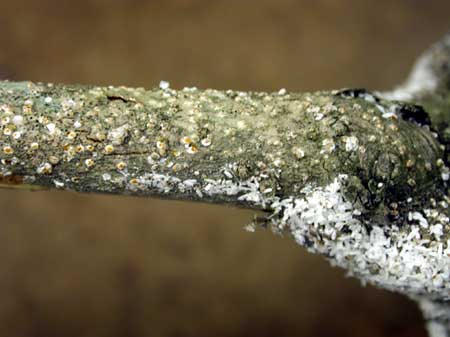Introduction
White prunicola scale (Pseudaulalacaspis prunicola) is an armored scale insect that infects members of the Prunus species, and various other ornamental plants. It is one of the most significant pests of cherry and peach trees. The insect is native to Asia. It has also become established in the United States. It likely migrated to the United States on shipping materials imported from China or Japan. White prunicola scale is a ravenous insect. It feeds persistently, extracting plant liquids from vulnerable hosts. Infested plants often decline rapidly, with many succumbing to infestation within a few years. White prunicola scale is often mistaken for another armored scale insect: white peach scale.
Distribution & Habitat
White prunicola scale is prevalent across China, India, Japan, South Korea, and Taiwan. It also occurs in the United States, where it has been observed in numerous northern, southern, and mid-western states, including Alabama, California, Connecticut, Florida, Louisiana, Maryland, Massachusetts, Mississippi, New Jersey, New York, North Carolina, Ohio, Oregon, Pennsylvania, Rhode Island, Virginia, and West Virginia, as well as in the District of Columbia.
Hosts
White prunicola scale is most partial to members of the Prunus species, peach chinaberry, flowering peach, French mulberry, and persimmon. It may also attack boxwood, catalpa, cherry laurel, euonymus, forsythia, Japanese flowering cherry, ligustrum, lilac, magnolia, privet, red twig dogwood, rhododendron, salix spp., and walnut.
Description
White prunicola scale produces salmon colored eggs. The larvae, or crawlers, are tiny, and have a pink to salmon coloration. Both genders possess elongated mouthparts, which combine to form a stylet. The crawlers insert their stylets into their hosts to feed. The adults are soft-bodied. They range from creamy white to yellow-orange in color. The armored coverings crafted by the females are circular and white. The male coverings are smaller and elongated, but also white. The males develop wings that they use to locate potential mates.
Life Cycle
White prunicola scale produces up to three generations per year, depending on the geographic location. The fertilized adult females attach themselves to the bark of the the host, and overwinter. They are concealed from the frigid temperatures by their armored coverings. The females resume activity the following spring. From early to mid May, the females deposit around 100 eggs each beneath their coverings. The eggs hatch within 2 to 3 weeks, revealing the first generation of larvae. The larvae, also referred to as crawlers, immediately set out to find suitable feeding sites. Once the crawlers have settled, they insert their mouthparts into the host, and commence feeding on sap and other plant liquids. Crawlers of the spring generation continue feeding, rapidly increase in size. They reach full maturity by mid-June. As the crawlers feed, they gradually secrete a waxy material that they use to construct their armored coverings. When the crawlers have matured, the males use their wings to navigate to the females. The females release a pheromone, which assists the males in detecting them. After the adults have mated, the males expire. The females lay the eggs of the summer generation throughout July, dying soon thereafter. The eggs hatch in 1 to 2 weeks. Development of the summer and fall generations tends to occur much faster. The summer brood feeds until it matures in late August or early September. The fall brood generally feeds until October, when it matures, or overwinters.
Symptoms of Infestation
When scale populations are abundant, they will appear as white, cottony masses on the bark of their hosts. Heavy infestations will cause new growth to be stunted. Existing twigs and branches will often die back. The leaves of infested plants may yellow or brown prematurely. Eventually, the leaves will be cast. On fruit trees, the size and yield of the fruit may be drastically reduced. Most plants will succumb to infestation from white prunicola scale within 2 to 3 years.
Management
- Remove and dispose of branches that exhibit symptoms of severe infestation.
- Plants can be sprayed with a horticultural oil during the dormant season to control scale populations. Multiple applications may be necessary to eliminate large scale populations.
- Various parasites and predators are effective at limiting scale populations when they are present.
- Ensure that trees are sufficiently watered, especially during extended periods of drought.
- Maintain plant vigor through sound cultural practices. Properly fertilize plants to promote new, healthy growth. Avoid over-fertilization of infested plants.
- Apply a layer of organic soil around the base of vulnerable plants to improve the soil quality.
- Contact insecticides can be employed to combat the crawlers after they have emerged. Applications should begin in early spring, after the dormant season has concluded. Subsequent applications can be performed at four to six week intervals, as needed.
- Infested bark can be scrubbed with a soft brush, or power-washed to dislodge the adults and crawlers. This method is not as effective when populations are large.
Photo courtesy of Cornell Cooperative Extension


